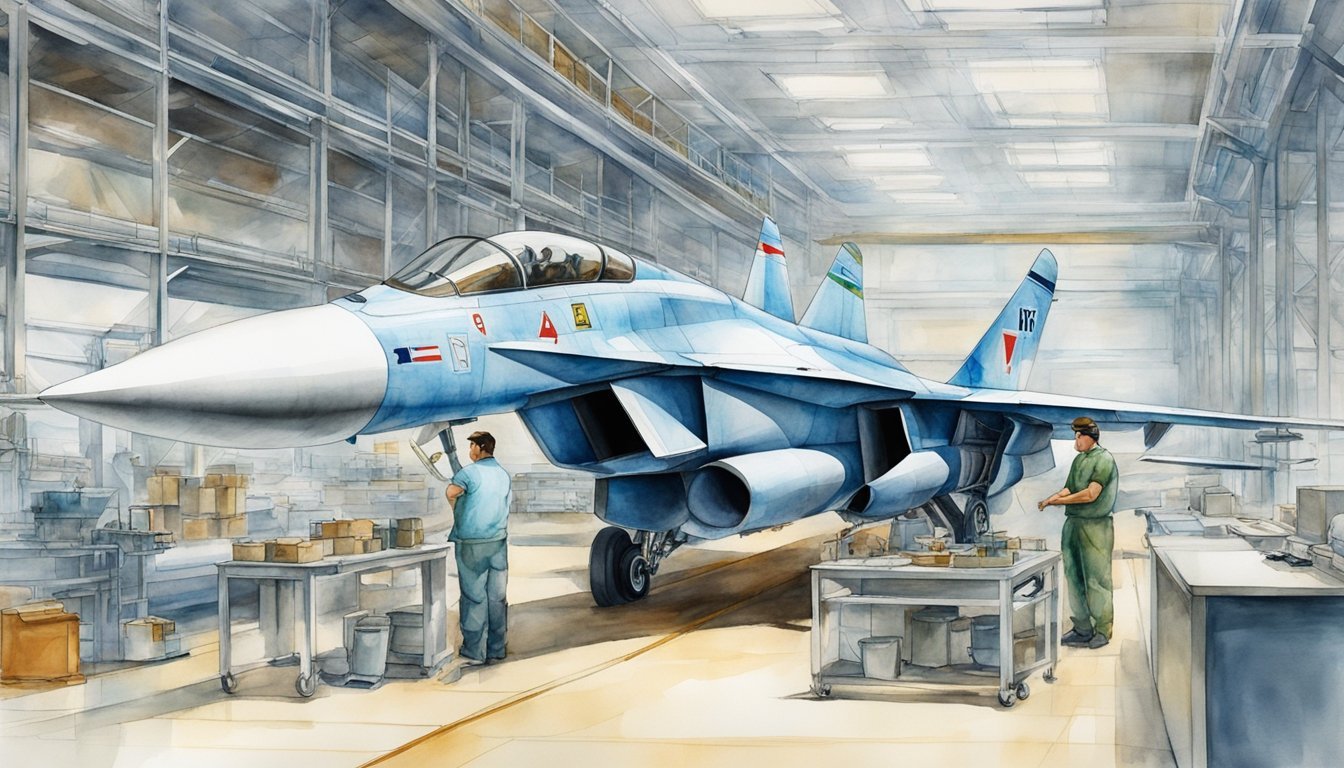Development and Design

The Mikoyan MiG-29, also known as “Fulcrum,” is a significant fighter aircraft developed to maintain air superiority for the Soviet Union. From its first flight to becoming a multirole combat fighter, the design evolution of the MiG-29 showcases impressive feats in aviation technology.
Origins of the MiG-29
The MiG-29 traces its roots back to the Cold War, responding to sophisticated U.S. fighters like the F-15 Eagle and the F-16 Fighting Falcon. Design work on this twin-engine, single-seat jet began in the early 1970s by the Mikoyan Design Bureau. The construction aimed to match and surpass opposing fighters’ capabilities, taking aerodynamic and avionic lessons from earlier jet designs. The aircraft’s aerodynamics allowed for impressive agility, crucial for air combat maneuvering.
Specifications and Avionics
The MiG-29 integrated advanced radar systems and sophisticated avionics, ensuring the aircraft could operate at high speeds and with accuracy. Its radar was capable of tracking multiple targets, supporting the role of air superiority. With a maximum speed of over 2,200 km/h (Mach 2), the MiG-29 stood among the fastest jets of its time. The cockpit’s design evolved to include glass cockpits in later variants, improving pilot interface and reducing workload.
Variants and Upgrades
Several variants of the MiG-29 have been developed over the years, enhancing its capabilities. The MiG-29M and MiG-29K were introduced as advanced versions with improved multirole capabilities. The newer MiG-35, which is a further development of the MiG-29M, extended these capabilities further. These models featured more powerful engines and additional hardpoints for various weapons, confirming the aircraft’s versatility in different combat roles. A carrier-based version, the MiG-29K, was developed specifically to operate from aircraft carriers, bringing the formidable power of the Fulcrum to the seas. Each new iteration of the MiG-29 confirmed the original prototype’s legacy and the prowess of the Mikoyan Design Bureau in producing combat-effective fighter jets.
Operational History

The Mikoyan MiG-29, also known as the Fulcrum, has been a prominent fighter in the combat and defense structures of multiple nations since its induction during the Cold War era.
Global Deployment
The Soviet Air Force initially received the MiG-29 in the early 1980s. Its introduction was a direct response to advanced American fighters like the F-15 Eagle and F-16 Fighting Falcon. Post-Cold War, the dissolution of the Soviet Union saw the distribution of the MiG-29 to various former Warsaw Pact countries, including the Luftwaffe of reunified Germany, which inherited the aircraft from the East German Air Force. The fighter jet has since found a place in various air forces across the globe, including the Indian, Ukrainian, and Polish Air Forces. For instance, India has been operating the MiG-29 since the 1980s and has integrated them aboard its aircraft carrier, the INS Vikramaditya.
- Soviet Air Force: Introduced in 1983.
- German Luftwaffe: Inherited after reunification.
- Indian Air Force: In service since the 1980s; modified for aircraft carrier use.
- Polish Air Force: Continues to operate updated versions.
Combat Performance
Throughout its operational history, the MiG-29 has been tested in various regional conflicts, affirming its capabilities as an air superiority fighter. In particular, the aircraft has been employed effectively for air defense missions and has been noted for its exceptional dogfighting abilities, enabled by its advanced air-to-air missiles and aircraft gun. It has seen action in a number of conflicts post-Soviet Union, providing valuable combat experience and feedback for future enhancements.
- Notable conflicts: Various post-Soviet regional conflicts.
- Strengths: Air-to-air combat and air defense missions.
Modern Upgrades and Sales
Following technological advancements, the MiG-29 has undergone several modernization efforts to extend its service life and enhance its multirole mission capabilities. The MiG-29SMT variant is one such upgrade that provides improved avionics and weapon systems. Countries like India have initiated upgrade programmes to bolster the performance of their fleet. Sales of the MiG-29 continue, reflecting ongoing interest and confidence in the aircraft’s operational capabilities.
- MiG-29SMT: Example of upgraded avionics and weaponry.
- Modernization efforts: In countries like India for extended service life.
- Continued sales: Signifying the aircraft’s relevance in modern air forces.
For more detailed insights on the aircraft’s service record, in-depth descriptions of its combat performance can be found at Military Factory alongside a closer look at modern upgrades and ongoing relevance through Defensebridge’s article.

